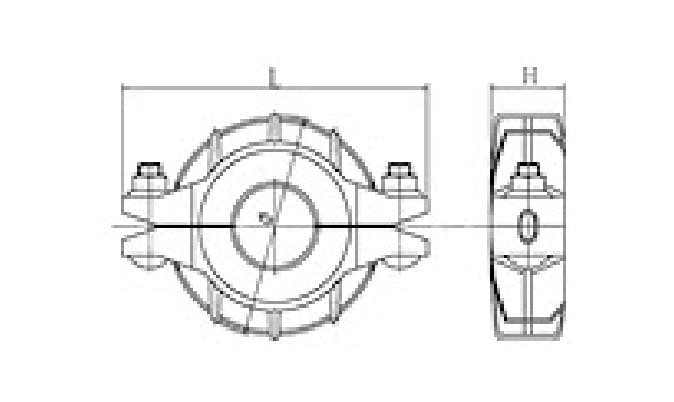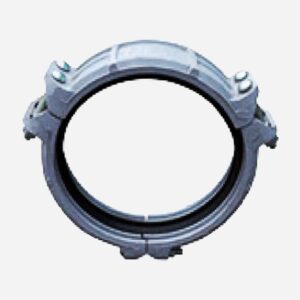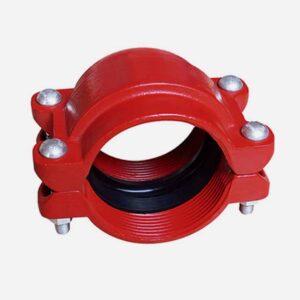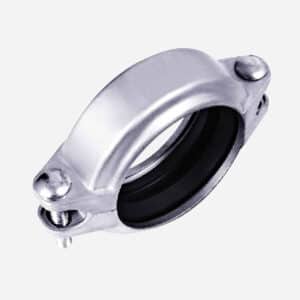Reducing Coupling
Reducing Coupling is a type of pipe fitting used to connect two pipes of different diameters. Its primary function is to transition between a smaller diameter pipe and a larger diameter pipe, allowing the flow of fluid to continue smoothly through the system. Reducing Couplings are commonly used in systems where pipe sizes need to be changed to accommodate different flow requirements or configuration needs. There are two types of Reducing Couplings: Concentric Reducing Coupling, where both ends are aligned along the centerline, which is suitable for most general applications, and Eccentric Reducing Coupling, where one end is aligned to a flat plane, often used in drainage systems or liquid transport systems to prevent air pockets from forming.

DRAWING

Dimension
| Nominal diameter(mm) | Pipe outside Diameter(mm) | Working Pressure(Mpa/psi) | Size of bolts&nuts | Ф | L | H |
|---|---|---|---|---|---|---|
| 50X40 | 60.3X48.3 | 2.5 | 2-M10X55 | 90 | 129 | 47 |
| 65X40 | 73.0X48.3 | 2.5 | 2-M10X55 | 101 | 137 | 48 |
| 65X50 | 73X60.3 | 2.5 | 2-M10X55 | 101 | 137 | 48 |
| 65X40 | 76.1X48.3 | 2.5 | 2-M10X55 | 105 | 140 | 48 |
| 65X50 | 76.1X60.3 | 2.5 | 2-M10X55 | 105 | 140 | 48 |
| 80X50 | 88.9X60.3 | 2.5 | 2-M10X55 | 120 | 164 | 48 |
| 80X65 | 88.9X73 | 2.5 | 2-M12X65 | 120 | 164 | 48 |
| 80X65 | 88.9X76.1 | 2.5 | 2-M12X65 | 120 | 164 | 48 |
| 100X40 | 114.3X48.3 | 2.5 | 2-M12X65 | 150 | 195 | 49 |
| 100X50 | 114.3X60.3 | 2.5 | 2-M12X65 | 150 | 195 | 49 |
| 100X65 | 114.3X76.1 | 2.5 | 2-M12X65 | 150 | 195 | 49 |
| 100X80 | 114.3X88.9 | 2.5 | 2-M12X65 | 150 | 195 | 49 |
| 150X100 | 165.1X114.3 | 2.5 | 2-M12X75 | 203 | 235 | 50 |
| 150X80 | 168.3X88.9 | 2.5 | 2-M12X75 | 203 | 235 | 50 |
| 150X100 | 168.3X114.3 | 2.5 | 2-M12X75 | 203 | 235 | 50 |
| 200X150 | 219.1X168.3 | 2.5 | 2-M16X110 | 264 | 312 | 60 |
Application
Reducing Couplings can be made from various materials, each suitable for different types of pipelines and industries, based on their specific requirements like pressure, temperature, corrosion resistance, and other environmental factors. Below are some common materials used for Reducing Couplings and the types of pipelines and industries where they are most suitable:
1. Stainless Steel (e.g., SS304, SS316, etc.) Suitable Pipelines
_
Used in a variety of industries where strength, durability, and resistance to corrosion are critical.
● Applications:
Water Supply Systems:
Stainless steel is ideal for potable water systems because of its resistance to rust and corrosion.
Natural Gas and Oil Pipelines:
Stainless steel provides excellent resistance to high pressures, temperature variations, and corrosive substances found in gas and oil transport.
Chemical Industry:
Its resistance to corrosive chemicals makes stainless steel a common choice for pipelines in chemical plants.
● Why Use:
Stainless steel offers high strength, corrosion resistance, and is suitable for both high and low temperatures, making it ideal for a range of demanding applications.
● Recommended Style:
Concentric Reducing Couplings are commonly used for stainless steel, as they ensure smooth flow without creating air pockets.
2. Copper Suitable Pipelines
_
Used primarily in plumbing, HVAC (heating, ventilation, and air conditioning) systems, and water supply systems.
● Applications:
Water Supply Systems:
Copper is corrosion-resistant and ideal for carrying water, particularly in residential and commercial applications.
HVAC Systems:
Copper’s excellent heat conductivity makes it suitable for refrigerant lines.
● Why Use:
Copper is highly resistant to corrosion, easy to install, and offers good strength, particularly in systems carrying water or refrigerants.
● Recommended Style:
Concentric Reducing Couplings are typically used with copper pipes because of their smooth and even transition between sizes.
3. PVC (Polyvinyl Chloride) Suitable Pipelines
_
Used in a variety of applications, including water distribution systems, drainage, and sewage lines.
● Applications:
Water Supply Systems:
PVC is lightweight, easy to install, and resistant to corrosion, making it common in municipal water supply systems.
Wastewater and Drainage Systems:
PVC is often used in drainage, stormwater systems, and sewage pipes due to its resistance to chemicals and low cost.
● Why Use:
PVC is cost-effective, resistant to corrosion, and easy to install, making it ideal for many low-pressure applications.
● Recommended Style:
Eccentric Reducing Couplings are often used in PVC systems, especially in drainage systems, where preventing air pockets is crucial.
4. Cast Iron Suitable Pipelines
_
Cast iron is used in heavy-duty applications, especially where strength and durability are needed in pressure systems.
● Applications:
Water and Sewage Systems:
Cast iron is widely used in municipal water supply, wastewater, and sewage systems due to its strength and ability to handle high-pressure environments.
Fire Protection Systems:
Cast iron is also used in fire protection systems due to its robustness and high resistance to pressure.
● Why Use:
Cast iron is durable, has high tensile strength, and is ideal for large-scale systems that require high resistance to pressure.
● Recommended Style:
Concentric Reducing Couplings are commonly used for cast iron, as they ensure smooth and reliable transitions between pipe sizes.
5. Ductile Iron Suitable Pipelines
_
Used in similar applications as cast iron but with enhanced strength and flexibility.
● Applications:
Water and Wastewater Systems:
Ductile iron is commonly used in water distribution and sewage systems where both strength and flexibility are needed.
● Why Use:
Ductile iron is stronger and more flexible than traditional cast iron, making it ideal for high-pressure applications in large pipe networks.
● Recommended Style:
Eccentric Reducing Couplings are often used to minimize the risk of air pockets in water and wastewater systems.
6. Carbon Steel Suitable Pipelines
_
Used in industries where high strength and resistance to high pressure are critical.
● Applications:
Oil and Gas Pipelines:
Carbon steel is commonly used in the oil and gas industry for both upstream and downstream pipeline systems.
Chemical Processing: It is used in pipelines carrying non-corrosive substances, such as hydrocarbons or some chemicals.
● Why Use:
Carbon steel is strong, durable, and can handle high pressure, making it suitable for heavy-duty applications, though it requires corrosion protection like coatings or linings.
● Recommended Style: Concentric Reducing Couplings are typically used, as they help maintain a smooth flow in high-pressure systems.
7. Aluminum Suitable Pipelines
_
Often used in lightweight and corrosion-resistant applications.
● Applications:
Air and Gas Systems:
Aluminum is commonly used in compressed air systems or low-pressure gas systems.
HVAC Systems:
It is used for systems that require light weight and resistance to corrosion, especially for ventilation pipes.
● Why Use:
Aluminum is lightweight, corrosion-resistant, and works well in low-pressure applications.
● Recommended Style:
Concentric Reducing Couplings are typically used with aluminum pipes for a smooth and reliable connection.
Choosing the Right Material and Style
WATER SYSTEMS
_
Stainless steel, copper, and PVC are commonly used. Stainless steel is preferred for high-pressure and corrosion-resistant applications, while PVC is more cost-effective for low-pressure systems.
GAS SYSTEMS
_
Stainless steel, carbon steel, and sometimes aluminum are used, depending on pressure requirements. Stainless steel is typically used for gas transmission due to its strength and resistance to high pressures and corrosion.
OIL AND CHEMICAL SYSTEMS
_
Carbon steel and stainless steel are often preferred due to their strength and ability to withstand harsh chemicals and high pressures.
WASTEWATER SYSTEMS
_
Ductile iron and cast iron are often used in these applications due to their durability and ability to handle high pressures.
In general, the choice of material for a Reducing Coupling depends on factors like the type of fluid or gas being transported, the operating pressure and temperature,
corrosion resistance, and the installation environment. Each material has its strengths and weaknesses, so the selection should be based on specific project needs.
RELATED PRODUCTS
Ring Joint Coupling

Coupling for HDPE Pipe

Stainless Steel Groove Coupling





